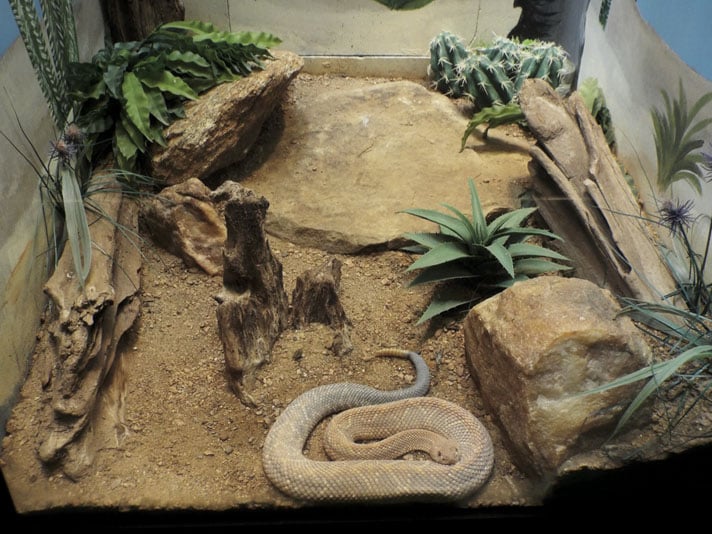Build the right enclosure for your desert species.
When most people think of the desert, they envision a dry, sandy expanse of vast and trackless wilderness, where no living thing, save a handful of rugged cacti and the occasional armor-plated scorpion, could survive. But the desert is actually a vibrant, intricate biome, teeming with diverse species of plants and animals. Lizards, snakes, tortoises, insects, cacti, flowers and even some species of amphibians have adapted to life in the harsh desert environment. Because of the oppressive heat and dryness of the desert, however, these species have adapted in very specialized ways. In fact, life in the desert is fraught with paradoxes; life hangs precariously between environmental extremes. While escaping the heat of the scorching desert sun is critical for survival, the sun’s rays also grant vitamin- and mineral-processing abilities to most desert herps. Thus, the sun’s rays are both the bringer of death and life for desert-dwellers.
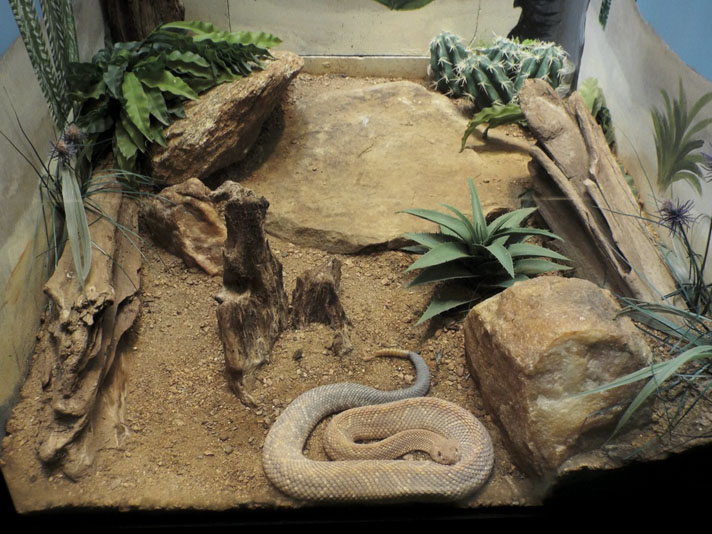
Philip Purser
An Aruba rattlesnake coils within its desert enclosure. These snakes are accustomed to rockier substrate.
Likewise, water is a paradox in this arid environment. While water is absolutely necessary to any animal’s survival, a build-up of humidity or extended exposure to standing pools of water may cause lung and skin disorders in some desert species. The hobbyist wishing to construct a desert-style terrarium needs to learn about the elemental paradoxes that are inherent in the desert ecosystem. A successful desert terrarium is built upon a balance of elemental extremes.
Not all deserts are created equal. There are rocky deserts with lower temperatures and higher levels of relative humidity, and there are sandy deserts with higher temperatures and much lower levels of relative humidity. Knowing the difference between these two desert types can make all the difference in the success or failure of a desert-terrarium endeavor. Building a successful desert terrarium in which the natural elements, such as plants, water, sunlight and reptiles, all live in harmony can be both challenging and deeply rewarding. Learning all you can about the desert’s natural elements is paramount to the long-term health and happiness of your desert-dwelling herps.
Two Types of Desert Terrariums: Sandy and Rocky
When building a desert terrarium, you must first establish which type of desert you wish to construct. There are two basic varieties, which I designate as the sandy desert and the rocky desert. These types differ in terms of temperature, humidity, vegetation and soil construction. The sandy desert, such as that found in northern Africa, is comprised of endless, rolling dunes of shifting sand. Such loose, liquid-like sand allows for “sand-swimming,” which is a form of locomotion whereby snakes and lizards move easily and swiftly beneath the surface of the sand, almost like a fish in water. These deserts have next to no stones or plants in their soil, and lots of very hot sunshine. Atmospheric humidity is exceptionally low in this desert type, but moisture seeping up through the loose sand does provide ample humidity for survival. Species such as the sandfish skink (Scincus scincus), the Kenyan sand boa (Gongylophis colubrinus), and numerous species of agamids, including the popular Uromastyx, are commonly kept species that will thrive in the sandy desert.
The second basic desert is the rocky type. This variety is typified by the presence of stones in the soil, more vegetative matter and the presence of rocky outcroppings. The shade, structure and stability added by stones and rocky outcroppings define the rocky-type desert environment. Temperatures are very hot and, owing to the presence of some plant life, relatively humidity may be higher than in the sandy desert habitat. Species that thrive in rocky desert include most desert tortoises and the African spur-thigh tortoise (Geochelone sulcata); snake species, ranging from the benevolent rosy boa (Lichanura trivirgata) to the deadly Mojave rattlesnake (Crotalus scutulatus); and a host of lizard species, including Schneider’s skink (Eumeces schneideri).
Sandy-Desert Terrarium
OK, let’s get started building some terrariums. First on the docket is the sandy-style terrarium. This style is meant to simulate the deserts of the world with very loose, sandy soil and large, rolling dunes, such as the Sahara and parts of the Mojave deserts. Begin constructing this style by selecting a long, broad, all-glass aquarium. I recommend a glass tank over an acrylic one for one simple reason: scratches. Sand will easily, and deeply, scratch acrylic tanks. Over time, the walls of the acrylic tank will become dull and eventually opaque due to the sand in the tank scratching the walls; this type of tank is literally sandblasted by the substrate of the terrarium. Glass is far more resistant to scratching than acrylic. It makes a much better choice for the desert enclosure. I also recommend a wide, long tank because most desert species need the horizontal room to slither or crawl about. Unlike jungle-dwelling species that utilize a high canopy, desert-going herps need less vertical height in their enclosures.
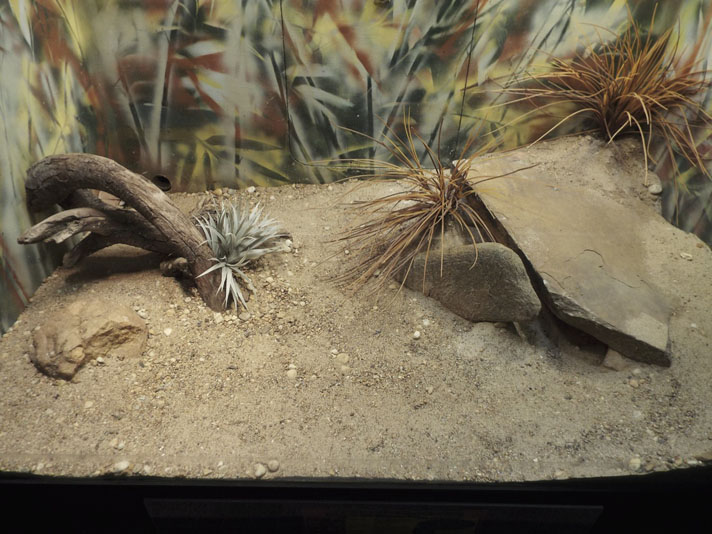
Philip Purser
Many desert species value both structure and open space. This terrarium satisfies both needs by keeping hides and structure toward the end, while maintaining a large, open area in the center.
Once you’ve selected a tank, get your sand. Pet stores sell designer sands, such as calcium-based sand, for desert-enclosures. There’s nothing wrong with purchasing these sands, though it can be expensive; a 10-pound bag of calcium sand may cost more than $15. The major benefit to these products is that, because they are calcium-based, they can pass more easily through a reptile’s digestive track without causing an impacted gut. An impacted gut occurs when a reptile devours too much sand and becomes fatally constipated. Your pet might ingest sand when feeding; a hungry bearded dragon might swallow some sand while recklessly gobbling up crickets from the floor of its desert-style home. In most cases, the reptile easily passes the devoured sand through its stool. If you ever notice your pet not pooping for several days, or if it seems to be in pain and looks bloated, take it to a herp-specific vet for treatment of an impacted gut. In all my years of keeping desert-dwelling herps, however, I have never had a single pet suffer from an impacted gut. I always employ fine-grain sand purchased from my local hardware store. Available in 50-pound bags that cost roughly $4, this sand is inexpensive.
Once you’ve gathered your tank and your sand, you need to wash the sand. This may sound odd, but bags of sand are loaded with dust and bits and debris. Accomplish this by filling a 5-gallon bucket half way up with sand. Then fill it the rest of the way with water. Churn the sand with your hands to unearth any dust and debris that is deep in the bucket. The water will turn a yellowish-tan color and look muddy. Pour off this muddy water. Repeat the process until the water in the sand bucket is clear. Normally, three to four rinses are sufficient to thoroughly wash your sand. Dry your sand by scooping it out and spreading it on a towel in the sun. Within a day, the sand should be dry.
Layer the sand 3 to 7 inches deep in the tank. Burrowing species, such as the sand boa or the sandfish skink, may require deeper substrate, while surface dwellers, such as the Uromastyx, will not require as thick a layer of substrate. Next, place some hides throughout the tank. The hides may range from artificial plastic hides to all-natural elements. Whatever you use should be big enough and deep enough for your herp to escape the hotter portions of the tank. One of the more attractive hides I’ve ever seen was in a colleague’s tank; he was housing a sidewinder rattlesnake (Crotalus cerastes) and used the skull of a longhorn steer as a hide. A deadly viper slithering through a bleached-bone skull made for a very sobering and awe-inspiring sight in his herp collection. More practical hides may be constructed from PVC pipe. Simply cut the PVC to an appropriate length, cap one end so the pipe doesn’t fill with sand, and insert the pipe into the substrate at an angle no steeper than 15 degrees, so that your pet can easily enter and exit the hide. For aesthetic beauty, shroud the opening of the PVC hide with stacked stones, dried twigs or other desert roughage. This will give the glaring-white PVC a much more natural look. I also recommend gluing a sheet of very rough sandpaper inside the pipe. Naked PVC is very smooth, and your pet might have a difficult time gaining traction on such a surface. A sandpaper coating will afford your pet much more traction.
Aside from the hides and the substrate, there are two other types of décor typically present in the desert terrarium: plants and stones. In the sandy tank, stones are kept to a minimum or left out altogether, as the species suited for life in these tanks seldom utilize rocks and stones for basking, and their subterranean movements can easily topple a precariously standing stone. Such undermining can cause the stone to fall and either damage or break the glass wall of the tank, or, worse yet, injure or kill your pet reptile. Stones anchored in the substrate only inhibit the movements of the species that thrive in the sandy environment. Thus, stones are not necessary in this type of desert enclosure. Like the stones, it’s not necessary to include plants in a sandy-style enclosure. Species such as the sandfish skink, the sand boas, the fringe-toed lizards and others come from areas in the wild where plant life is virtually non-existent. Having adapted to an existence without plant life of any kind, these reptiles prefer their habitat to be an ocean of loose sand. Some twigs or surface roughage (such as tumbleweed, etc.) might be useful in some sandy-desert terrariums, though this is largely determined by the aesthetic tastes of the keeper.
The final elements of the desert terrarium are heat, light and humidity. Heating should be in simulation of the native environment from which your chosen species of herp hails. Uromastyx, which come from the northern reaches of the Sahara desert, enjoy basking temperatures of 110 to 120 degrees Fahrenheit, while the Australian bearded dragon prefers hot spots of 95 to 100 degrees. Providing the proper amount of heat to suit your specific pet is paramount. Heat may be provided through any of the standard means, but some are more effective than others. Considering that you have layered several inches of sand in the bottom of your terrarium, an undertank heating pad will be very ineffective, as the heat generated by this device will not reach your herp. Clamp lamps with herp-specific bulbs are a good idea, while a ceramic heat emitter is your all-around best bet for providing steady, ample heat for your desert-dwelling reptile. All desert-going species must escape the heat of the day, however, by hiding in rock crevasses, caves, burrows, etc. It is absolutely critical that you provide a hot and cool end to your terrarium. Place your heat source over one end of the tank and leave the other end unheated. Placing hides at the cool end of the tank is also recommended for providing retreats for your pet.
Lighting in the desert is a very serious point to consider. Desert-going herps have evolved in such a way that they need long hours of very intense sunlight In order to thrive. Thus, full-spectrum bulbs should be on for 12 to 14 hours each day. For this, I use ReptiSun 10.0 UVB bulbs. Remember to make sure that any UV lighting your pet receives is not being filtered through glass, as this will strip the lighting of most of its ultra-violet radiation, thereby robbing your pet of its much-needed UV rays. The type and duration of lighting you employ in your desert-style terrarium will be determined by the species that you keep. Herbivorous lizard species, such as the desert iguana (Dipsosaurus dorsalis), require much more intense lighting than, for instance, a subterranean sand boa, in order to properly metabolize their food and vitamin/mineral intake. Thus, the lighting requirements of these two desert-dwellers are not the same.
A final point of consideration is humidity. You must provide your pets with ample drinking water, while staying conscious of the fact that excessive levels of relative humidity can kill desert herps by giving them pneumonia or other lung and skin diseases. Species that are particularly vulnerable to such respiratory and dermal disorders are the rosy boas, which are native to deserts of the American Southwest.
Achieve a proper level of humidity through two avenues: place a dish of standing water at your pet’s disposal for drinking, and pipe small amounts of water into the substrate to generate moisture in the tank. Keep the dish of water as small as possible. Some desert snakes, such as the rosy boa, have a bad habit of submerging themselves for long periods of time in water dishes that are too large, thereby causing blister disease or some other nasty ailment. Remember, the smaller the water dish, the better. You can add some general moisture to the tank by spraying water from a spray bottle into the hides every day. This will simulate a dark, moist retreat for your pet. I also recommend placing a short length of PVC pipe (very narrow in diameter) upright in the corner of the sandy-desert terrarium and pouring small amounts of water down the pipe weekly. This water will reach the lower depths of the sand and diffuse throughout the substrate, thereby adding much-needed moisture to the tank without overwhelming the relative humidity of the tank.
The sandy-desert style terrarium is best maintained at relative humidity levels of 20 to 35 percent, depending on species being housed. Many species, such as Uromastyx, will get most of their moisture from the vegetables they eat.
Another key aspect of all desert environments is high wind and ample ventilation. Use screen lids, tanks with vented walls or screen walls in order to maximize air flow.
Rocky-Desert Terrarium
Made to simulate the world’s rockier deserts, this biome type is defined by higher levels of relative humidity, the presence of numerous plant species and hard-packed, rocky soil. Species that need to freely “swim” through loose sands, such as the Kenyan sand boa or the sandfish skink, are ill-suited to life in the rocky-desert terrarium. Species that thrive in this style of terrarium include leopard geckos (Eublepharis macularius), African fat-tailed geckos (Hemitheconyx caudicinctus), gopher snakes (Pituophis spp.), many species of western kingsnake (Lampropeltis spp.), and numerous species of monitor lizard (Varanus spp.).
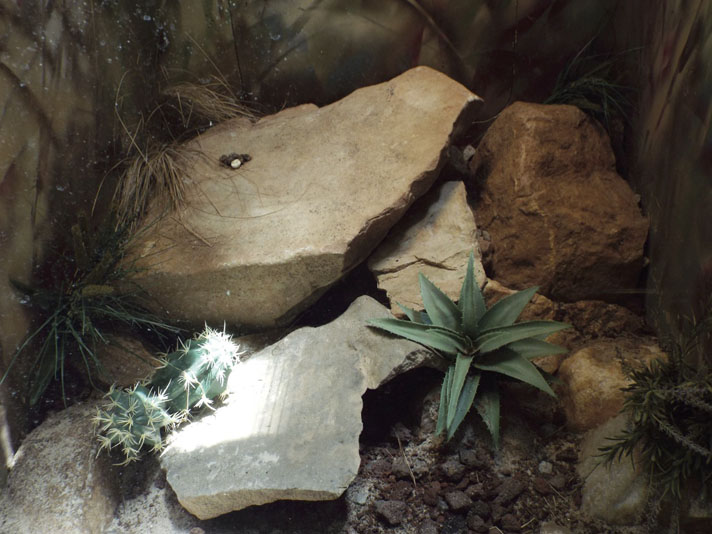
Philip Purser
An example of a rocky desert terrarium. Make sure the rocks are sealed in place and are not a danger to the inhabitants.
Keepers of “hot” or venomous herps are also in luck when it comes to the rocky-desert environment, as this biome type hosts more types of pit viper and cobra species than any other biome type on the planet. Even the venomous lizards—the Mexican beaded-lizard (Heloderma horridum) and the Gila monster (H. suspectum)—make their homes in the rocky-desert environment. Several of the African tortoises may also thrive under the conditions presented in the rocky-desert environment.
Establish the rocky desert by creating a sand-pebble mixture (two parts pebble to one part sand) that layers roughly 3 to 4 inches deep for non-burrowing species and 6 inches deep for burrowing species. Establish hides of PVC as described for the sandy-desert environment, though hides made of bark slabs are also effective. Heating and lighting requirements are as described for the sandy desert, and will vary based on the individual needs of your pets. Moisture levels are less stringent in the rocky-desert terrarium, as the inhabitants of this biome are tolerant of a wider range of humidity. I recommend keeping relative humidity levels below 40 percent, but larger watering dishes or even shallow bathing pools (good for monitor lizards and tortoises) are acceptable. If you include a larger water dish in your rocky-desert terrarium, keep in mind that ample ventilation is absolutely necessary; water evaporating from this dish must not be allowed to build up inside the terrarium. All the rules as described for the lighting, heating and thermocline of the sandy-desert tank apply to the rocky-desert terrarium.
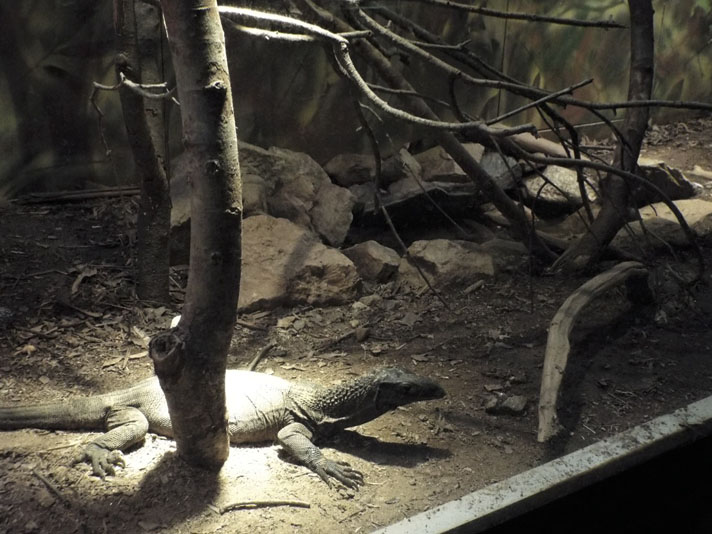
: Philip purser
The desert is easy to maintain in very large enclosures. Note how this adult monitor lizard is at home amid sandy substrate, large climbing branches and cobble or small boulder-size stones.
Live plants are a wonderful addition to a rocky-style terrarium. I recommend keeping any potted plants inside their pots and anchoring the pots directly into the substrate of the terrarium. Soft-bodied species of lizard, such as African fat-tailed geckos, should not be kept with cactus-like plants, as the spines of these plants can easily cut or pierce such pets’ delicate skin. Tougher, heavily armored species, such as the African plated lizards, can be housed with spiny plants. Very large specimens (monitors, tortoises, etc.) may crush plants by their movements within the tank.
Some great desert plants to include in your rocky-desert terrarium include Aloe, Conophytum, Echeveria, Fritha, Hawthoria, Sansevieria, Sedum, and Sempervivum. Anchoring a plant in the substrate of the tank while still inside its pot allows you to water the plant as needed without over-saturating the entire substrate of the terrarium, thereby raising the relative humidity in the terrarium to unacceptably high levels. Herbivorous species, such as the chuckwalla (Sauromalus ater), must not be housed with plants that pose a threat if consumed. Plants with toxic leaves or saps must be avoided when housing herbivorous species (a toxic plant list can be found here).
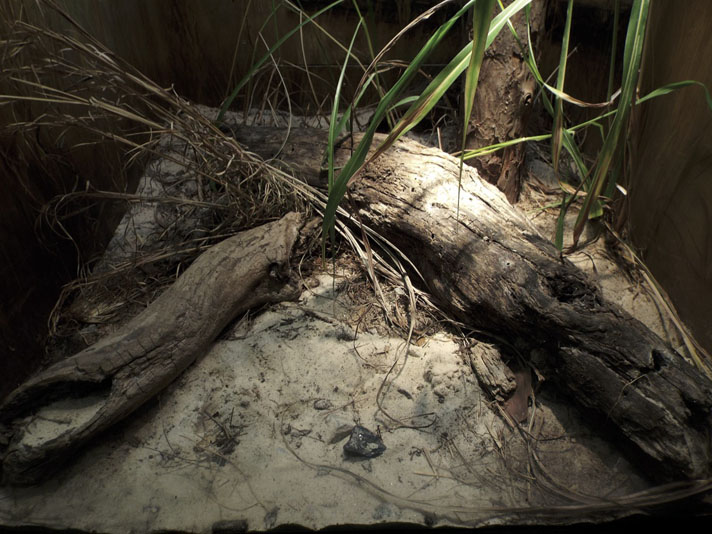
philip purser
Remember that large snakes will need large things to rub against when it comes time to shed their skin. The tangle of wooden branches in this habitat provide cover, and aid the inhabitant during times of shedding.
Stones are a major component of the rocky-desert terrarium. Large stones may be placed together in a cluster to simulate rocky outcroppings, which provide shelter and cover. Place these stones in close proximity to one another and situate them directly under the tank’s light source. This will create a superior basking site for your pet. Desert species, such as the collared lizard (Crotaphytis collaris), western swift (Sceloporus ssp.) and bearded dragons (Pogona ssp.) especially enjoy such haunts. Another good use of stones is to stack them to make tighter hides and retreats for other species, such as sungazers (Cordylus giganteus) and plated lizards (family Gerrhosauridae).
I cannot stress enough that stacked stones must be cemented or bolted together in order to prevent their falling or shifting. Falling stones have crushed to death many pet reptiles and broken the walls of many glass terrariums. Don’t let this happen to yours. Cement stones with a non-toxic adhesive or industrial sealing compound, such as caulk or rubber cement. Non-brittle rocks which do not crumble easily can also be drilled and bolted together. This is a favorite tactic of hobbyists wishing to reorganize or reconfigure their rocky outcropping, as the bolts may easily be removed and the entire structure can be modified or rearranged as desired.
Additional Reading
I could go on and on about the nuances and intricacies of the sandy- and rocky-desert environments. An article as brief as this one, however, can only cover the very basics of how to build and maintain a desert-style terrarium. For further reading into this subject, check out my book, Natural Terrariums (TFH publications, 2007). While the entire book is packed with tips on establishing desert-style terrariums and selecting the species you wish to house therein, chapter 7 has a long section dedicated exclusively to the desert-style terrariums. I also highly recommend Philippe de Vosjoli’s Design & Maintenance of Desert Vivaria (Advanced Vivarium Systems publications, 2001). This text is extremely informative and is especially helpful to newcomers and novice hobbyists wishing to build a desert-style tank for the first time.
As always, I recommend reading all you can on the topic before undertaking any type of reptile or amphibian project. In the end, you—and your pet herps—will be very glad that you did.
Philip Purser, Ph.D., lives in Tampa, Florida, where he is a professor at Hillsborough Community College. An avid angler and naturalist, Phil’s areas of reptile expertise include rosy boas, geckos, and all manner of colubrid snake species. Phil’s greatest reptilian passion, however, are the rattlesnakes.

